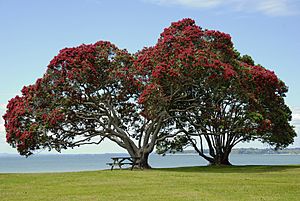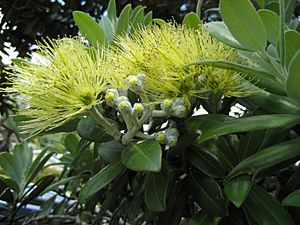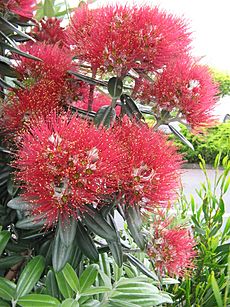New Zealand Christmas bush facts for kids
Quick facts for kids Pohutukawa |
|
|---|---|
 |
|
| Pohutukawa trees | |
| Scientific classification | |
| Genus: |
Metrosideros
|
| Species: |
excelsa
|
| Synonyms | |
|
|
The Pohutukawa (Metrosideros excelsa) is a special evergreen tree found in New Zealand. It's also known as the New Zealand Christmas tree because it blooms with bright red flowers around Christmas time. These amazing flowers are made of many tiny stamens, which are the parts of a flower that produce pollen.
The Pohutukawa is part of the myrtle family and is one of twelve Metrosideros species that only grow in New Zealand. It's famous for its bright colors and its ability to grow even on rocky cliffs. Because of its strength and beauty, it's very important in New Zealand culture. The Māori people, who are the native people of New Zealand, see it as a very important tree, calling it rākau rangatira. The tree's blossom is called kahika.
Contents
What's in a Name?
The scientific name Metrosideros comes from ancient Greek words. Metra means "heartwood" (the strong inner part of a tree trunk), and sideron means "iron". So, it's like "iron heartwood," which shows how strong the wood is!
The second part of its name, excelsa, is from Latin and means "highest" or "sublime". This might refer to how tall the tree can grow.
The name Pōhutukawa is a Māori word. It's similar to the Cook Island Māori word po'utukava, which describes a different coastal plant with white berries. The -hutu- part of the name is linked to a Polynesian word for the fish-poison tree, which has flowers that look a bit like the Pohutukawa's.
What Does a Pohutukawa Look Like?
Pohutukawa trees can grow very tall, up to 25 meters (about 82 feet) high. They often have a wide, dome-like shape. Many Pohutukawa trees have several trunks and branches that are covered with tangled, fibrous aerial roots. These roots hang down from the branches.
The leaves of the Pohutukawa are oblong, which means they are longer than they are wide. They feel leathery and have dense white hairs on their undersides.
When Does the Pohutukawa Flower?
The Pohutukawa usually flowers from November to January. The best time to see its bright crimson flowers is in mid to late December, just in time for summer. This is why it's called the New Zealand Christmas tree!
Not all trees flower at the exact same time, and their flowers can be different shades of red. Some trees around the Rotorua lakes even have pinkish flowers. There's also a rare yellow-flowered type called 'Aurea'. This special yellow Pohutukawa came from two trees found on Mōtiti Island in 1940.
Where Do Pohutukawa Trees Grow?
Naturally, Pohutukawa trees grow along the coast of the North Island of New Zealand. They used to form a continuous line along the coast from New Plymouth to Gisborne. However, by the 1990s, farming and introduced pests had destroyed over 90% of these forests.
You can also find Pohutukawa trees naturally around the lakes in the Rotorua area and in Abel Tasman National Park at the top of the South Island.
These trees are famous for growing on cliffs. They can hold on tightly even in very steep places. Like their Hawaiian relative, the ʻōhiʻa lehua tree, Pohutukawa trees are good at growing on new lava fields. A great example is on Rangitoto Island, a volcanic island in the Hauraki Gulf.
Famous Pohutukawa Trees
There's a huge Pohutukawa tree in Te Araroa on the East Coast of New Zealand. It's thought to be the biggest in the country, standing 20 meters (about 66 feet) tall with branches spreading 38 meters (about 125 feet) wide!
Another famous Pohutukawa, called 'Te Hā,' is in an Auckland City park. It's estimated to be 180 years old and is the largest urban Pohutukawa in New Zealand.
Protecting the Pohutukawa
In New Zealand, Pohutukawa trees are in danger from an animal called the common brushtail possum. These possums eat the leaves off the trees, which can harm or even kill them.
A charity called Project Crimson is working to help Pohutukawa and other Metrosideros trees. Their goal is to help these trees grow strong again in their natural homes. They want Pohutukawa and Rata trees to be important symbols for all New Zealanders.
How People Use Pohutukawa
Pohutukawa wood is very strong and dense. The Māori people used it to make tools like beaters and other heavy items. It was also often used in shipbuilding because its naturally curved shapes were perfect for making strong "knees" (curved pieces of wood used to join parts of a ship).
In traditional Māori healing, extracts from the Pohutukawa were used to treat problems like diarrhea, sore throats, and wounds.
Growing Pohutukawa Trees
Pohutukawa trees are popular to grow in gardens and parks. You can find beautiful examples in many coastal cities in the North Island. They are strong and easy to grow, even in places south of their natural range. They have started to grow naturally in the Wellington area and the northern South Island.
Pohutukawa trees have also been introduced to other countries with warm climates. In parts of south-eastern Australia, they are growing naturally on coastal cliffs near Sydney. In coastal California, they are popular street and lawn trees. However, in San Francisco, their strong root systems have sometimes damaged sewer lines and sidewalks. In some parts of South Africa, Pohutukawa trees grow so well that they are considered an invasive species, meaning they can take over from native plants. The Spanish city of A Coruña has even chosen the Pohutukawa as its special flower symbol.
There are at least 39 different types, or "cultivars," of Pohutukawa that have been developed. These include varieties with different flower colors or growth habits. For example, some have yellow flowers, while others have unique leaf patterns.
| Cultivar name | Year introduced | Flower colour | Introduced by | Notes |
|---|---|---|---|---|
| M. excelsa ‘Aurea’ | 1947 | Greenish-yellow | Duncan & Davies | Came from Motiti Island. |
| M. excelsa ‘Blockhouse Bay’ | mid-1980s | Bright red | Graeme Platt | Came from Blockhouse Bay, Auckland. |
| M. excelsa ‘Butterscotch’ | 1993 | Fire Red | Duncan & Davies | Has reddish stems and new leaves that turn yellow, then green. Came from M. excelsa ‘Sunglow'. |
| M. excelsa ‘Centennial’ | - | - | Graeme Platt | Has leaves with a reverse pattern (darker edges, lighter center). Grows upright. Came from Auckland Domain. |
| M. excelsa ‘Christmas Cheer’ | - | Crimson | Bob Bayly | Flowers reliably around Christmas time in large clusters. |
| M. excelsa ‘Dalese’ | 2010 | Orange-red | Lyndale Nurseries | A small, low-growing type. |
| M. excelsa ‘Fire Mountain’ | mid-1970s | Orange-scarlet | Felix Jury / Duncan & Davies | Has very bright flowers and a spreading shape. Came from Waitara riverbank. |
| M. excelsa ‘Firestone’ | 1983 | Fire-red | Graeme Platt | Has bright flowers and a sprawling shape. Came from Mt Moehau, Coromandel Peninsula. |
| M. excelsa ‘Flame Crest’ | 1991 | Orange-scarlet | Cyril Watson & George Smith / Duncan & Davies | A tall, upright type. Came from Kawaroa Park, New Plymouth. |
| M. excelsa ‘Gold Finger’ | 1986 | Deep crimson | Duncan & Davies | Has bright gold leaves with a reverse pattern. |
| M. excelsa ‘Golden Dawn’ | 2003 | Melon Pink | Robert Harrison | Has leaves with a reverse pattern. Grows to about 5 meters. |
| M. excelsa ‘Gold Nugget’ | 2000 | - | Jim Rumbal / Duncan & Davies | Has green leaves with yellow centers. |
| M. excelsa ‘‘Hauraki’ | - | Red | Graeme Platt | Has very large flowers and a tall, upright shape. Came from Long Bay Regional Park, Auckland. |
| M. excelsa ‘Kopere’ | 2007 | Orange-red | Graeme Platt | Has vibrant flowers and shiny green leaves. Came from Brooks Bay, near Awhitu Regional Park, Auckland. |
| M. excelsa ‘Lighthouse’ | 1983 | Crimson | Graeme Platt | Flowers early (November). Came from Rangitoto Island. |
| M. excelsa ‘Manukau’ | 1990 | Orange-red | Graeme Platt | Has well-balanced flowers that also bloom inside the tree's canopy. Came from Manukau City shopping center. |
| M. excelsa ‘Maori Princess’ | 1970s | Red | Ian McDowell / Duncan & Davies | An upright tree with open branches. Came from Brougham Street, New Plymouth. |
| M. excelsa ‘Midas’ | 1988 | Red | William (Bill) Robertson | Has leaves with a reverse pattern, but it can sometimes change back to plain leaves. |
| M. excelsa ‘Mini Christmas’ | - | Red | A small type that grows to about 1 meter tall. | |
| M. excelsa ‘Moon Maiden’ | 1988 | Sulphur yellow | Duncan & Davies | Has light grey-green leaves. Came from M. excelsa ‘Aurea'. |
| M. excelsa ‘Mt Maunganui’ | 1993 | Red | Lyndale Nurseries | Came from Pitau Road, Mount Maunganui. |
| M. excelsa ‘Octopussy’ | 2004 | Red | Naturally Native NZ Plants Auckland | Has a weeping shape (branches hang down). |
| M. excelsa ‘Ohope’ | - | Red | Duncan & Davies | Has green leaves with cream edges. |
| M. excelsa ‘Parnell’ | early 1970s | Red | Graeme Platt | A very large, wide-spreading tree. Came from Parnell Rose Gardens, Auckland. |
| M. excelsa ‘Pink Lady’ | 1988 | Melon Pink | Duncan & Davies | A small, upright tree with compact flower heads. |
| M. excelsa ‘Plus Four’ | 2002 | Bright Red | Graeme Platt | Has an upright shape. Came from Awhitu Golf Course, Auckland. |
| M. excelsa ‘Pouawa’ | - | - | Graeme Platt / Rob Bayly | Has flowers that last a long time. Came from north of Gisborne. |
| M. excelsa ‘Rangitoto’ | mid-1980s | Dark Red | Tom Johnson / Dawn Nurseries | An upright, smaller tree. Came from Te Atatū, Auckland. |
| M. excelsa ‘Royal Flame’ | 1988 | Deep-crimson | Jim Rumbal / Duncan & Davies | An upright tree with yellow parts in its flowers. Came from Waitara West Marine Park. |
| M. excelsa ‘Scarlet Pimpernel’ | 1976 | Scarlet | Felix Jury / Duncan & Davies | A small, compact type. Good for pots. Came from Princess Street, Waitara. |
| M. excelsa ‘Sunglow’ | 1980 | - | Duncan & Davies | Has gold leaf edges. |
| M. excelsa ‘Tamaki’ | 1985 | Orange-red | Graeme Platt | Has bright flowers. Came from Tamaki Drive, Auckland. |
| M. excelsa ‘Te Kaha’ | mid-1980s | Red with orange hints. | Graeme Platt | A medium-sized bushy tree. Came from Te Kaha Hotel, Bay of Plenty. |
| M. excelsa ‘Titirangi’ | late-1980s | Scarlet | Graeme Platt | An upright tree with many flowers. Came from Margan Ave, Auckland. |
| M. excelsa ‘Upper Hutt’ | - | - | - | Has leaves with a reverse pattern. Came from public gardens in Upper Hutt. |
| M. excelsa ‘Variegata’ | - | Red | - | Has patterned leaves. |
| M. excelsa ‘Vibrance’ | 1985 | Orange-red | Graeme Platt | Flowers have very long stamens. Came from Waiomu Bay, Coromandel Peninsula. |
| M. excelsa ‘Whakarewarewa’ | late-1980s | Very dark red | Graeme Platt | Came from Whakarewarewa, Rotorua. |
| M. excelsa ‘White Caps’ | 2009 | White | Graeme Platt | Came from Piha Beach, Auckland. |
See also
 In Spanish: Metrosideros excelsa para niños
In Spanish: Metrosideros excelsa para niños





